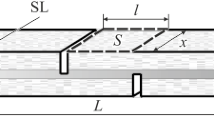Abstract
Wettability of a glass fabric was studied by use of a resin drop method. The mixing ratios of epoxy resin and anhydride hardener were adopted as 1:0.5, 1:1 and 1:1.2. A catalyst of 2-ethyl-4-methylimidazole added as much as 0.1wt% of the mixed resin. A curing analysis by differential scanning calorimeter (DSC) showed that the mixed resin could be infiltrative at room temperature. An effective contact angle and the height of the resin drop onto the glass fabric preset on a flat glass plate were measured as a function of time. The wet area of the resin drop was also measured. Behaviors of the contact angle, the drop height, the net wet area and the coefficient of wettability were analyzed in the glass fabric impregnation. The resin drop method was shown to be quite effective in evaluating the capillary-mode resin penetration into the fabric.
Similar content being viewed by others
References
J. D. Nam, S. J. Lee and K. J. Lee, Resin transfer molding for high performance composite materials, The Korea Journal of Rheology, 7(1) (1995) 1–9.
N. Pearcea, F. Guildb and J. Summerscales, A study of the effects of convergent flow fronts on the properties of fibre reinforced composites produced by RTM, Composites part A, 29A (1997) 141–152.
J. P. Coulter and S. I. Guceri, Resin impregnation during the manufacturing of composite materials subject to prescribed injection rate, Journal of Reinforces Plastics and Composites, 7(3) (1988) 200–219.
G. Kaptay, The threshold pressure of infiltration into fibrous preforms normal to the fibers’ axes, Composites Science and Technology, 68 (2008) 228–237.
S. Rebouillat, B. Steffenino and B. Salvador, Hydrodynamics of high-speed fibre impregnation: the fluid layer formation from the meniscus region, Chemical Engineering Science, 57 (2002) 3953–3966.
R. A. Saunders, C. Lekakou and M. G. Bader, Compression in the processing of polymer composites 1. A mechanical and microstructural study for different glass fabrics and resins, Composites Science and Technology, 59 (1999) 983–993.
H. Yamada, I. Mihata, T. Tomiyama and S. P. Walsh, Investigation of the fundamental causes of pinholes in SMC mouldings, Proceedings of SPI Composite Institutes 47th Annual Conference, Cincinatti SPI, New York (1992).
S. F. M. Almeida and Z. S. N. Neto, Effect of void content on the strength of composite laminate, Composite Structures, 28(2) (1994) 139–148.
N. C. W. Judd and W. W. Wright, Voids and their effects on the mechanical properties of composites; an appraisal, SAMPE Journal, January/February (1978) 10–14.
S. R. Ghiorse, Effect of void content on the mechanical properties of carbon/epoxy laminates, SAMPE Quarterly, 24(2) (1993) 54–59.
K. J. Bowles and S. Frimpong, Void effects on the interlaminar shear strength of unidirectional graphite fiberreinforced composites, Journal of Composite Materials, 26 (1992) 1487–1509.
D. Saihi, A. El-Achari, A. Ghenaim and C. Caze, Wettability of grafted poly(ethylene terephthalate) fibers, Polymer Testing, 21 (2002) 615–618.
C. Y. Lee, C. H. Kim, K. M. Choi, C. Y. Park and O. C. Kweon, Development of a novel system for measuring sizing degree based on contact angle(I), Journal of Korea Technical Association of the Pulp and Paper Industry, 35(3) (2003) 43–52.
B. Simoncic and V. Rozman, Wettability of cotton by aqueous solutions of surfactants with different structures, Colloids and Surfaces A: Physicochem. Eng. Aspects, 292 (2007) 236–245.
P. C. Hiemenz, Surface tension and contact angle(Chapter 6 in principles of colloid and surface chemistry), Second Ed. Marcel Dekker, New York, USA, (1986).
C. S. Wang and S. A. Iobst, Reducing fiber readout of structural composite panels, Journal of Reinforced Plastics and Composites, 28(19) (2009) 2377–2386.
Measuring and analyzing with ease (iSolution Lite), iM-Technology (Image & Microscope Technology), Daejeon, Korea, (2001).
K. J. Ahn, J. C. Seferis and J. C. Berg, Simultaneous measurements of permeability and capillary pressure of thermosetting matrices in woven fabric reinforcements, Polymer Composites, 12(3) (1991) 146–152.
J. G. Williams, C. E. M. Morris and B. C. Ennis, Liquid flow through aligned fiber beds, Polymer Engineering & Science, 14(6) (1974) 413–419.
C. H. Lee, S. H. Kim, S. W. Kim and K. J. Lee, An experimental study on the effect of capillary pressure on the void formation in resin transfer molding process, The Korea Journal of Rheology, 10(4) (1998) 185–194.
G. W. Lee, M. H. Lee, S. W. Kim and K. J. Lee, Experimental and numerical studies on the flow characteristics in resin transfer molding process, The Korea Journal of Rheology, 7(4) (1995) 139–149.
S. T. Nam, M. J. Han, H. S. Choi and Y. T. Park, Effect of physical properties of polymer solution on the thickness of ultrathin membrane prepared by water casting method, J. of Korean Ind. & Eng. Chemistry, 9(2) (1998) 200–206.
Author information
Authors and Affiliations
Corresponding author
Additional information
Recommended by Editor Jai Hak Park.
Seung-Wook Han received his Master’s degree from the Department of Mechanical Engineering, Hanyang University, Korea, 2011. His research interests are composites manufacturing and structural analysis.
Nak-Sam Choi received his Ph.D. degree from Kyushu University, Japan, 1990. He is currently a full-professor in the Department of Mechanical Engineering, Hanyang University, Korea. His research interests include the fatigue behavior of materials and composites, AE (acoustic emission) analysis, experimental methods for composites manufacture and reliability analysis.
Rights and permissions
About this article
Cite this article
Han, SW., Choi, NS. & Lee, MS. Analysis of glass fabric impregnation using a resin drop method. J Mech Sci Technol 26, 1477–1482 (2012). https://doi.org/10.1007/s12206-012-0341-7
Received:
Revised:
Accepted:
Published:
Issue Date:
DOI: https://doi.org/10.1007/s12206-012-0341-7




